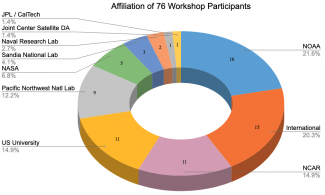An Earth System Model (ESM) is a model that represents various domains of the earth, such as atmosphere, ocean, sea ice, etc. A new community effort is underway to devise a method to transfer information easily and consistently between chemistry and aerosol modules, and other components of ESMs. Currently, it is difficult to study and quantify feedbacks of chemistry/aerosol parameterizations on weather and climate because of the structurally diverse ways in which chemistry/aerosols modules are integrated in ESMs. This complexity interferes with testing the aerosol/chemistry independently from the meteorology. Furthermore, the plethora of different structures used in the ESMs to connect the aerosol/chemistry modules makes it impossible to swap the modules between ESMs, making it difficult to isolate the uncertainties from the aerosol/chemistry module versus the atmospheric model. Improving the interoperability of aerosol/chemistry modules opens the door to addressing important uncertainties in ESM predictions, such as aerosol-cloud interactions, direct aerosol radiative effects, and climate impacts on air quality.
To find avenues for increased interoperability and collaborative research, the virtual Generalized Aerosol/Chemistry Interface Workshop was held on February 16, 2022. The organizing committee was international and multi-institutional: Natalie Mahowald (Cornell University), Alma Hodzic (NCAR), Ligia Bernardet (NOAA Global Systems Laboratory and DTC), Pete Bosler (Sandia National Laboratory), Tom Clune (NASA), Matt Dawson (NCAR), Barron Henderson (Environmental Protection Agency - EPA), Jeff Johnson (Cohere Consulting, LLC), Xiaohong Liu (Texas A&M University), Po-Lun Ma (Pacific Northwest National Laboratory, Naval Research Laboratory), Benjamin Murphy (EPA), Nicole Reimer (University of Illinois), and Michael Schulz (Meteorologisk institutt Norway).
The 76 workshop participants represented NOAA, many US National Laboratories (NCAR, Joint Center for Satellite Data Assimilation, NASA, Jet Propulsion Laboratory, DOE Pacific Northwest National Laboratory, Sandia National Laboratory), US Universities (California Irvine, Columbia, Cornell, Miami, Michigan, Texas A&M, New York SUNY), and international institutions (Brazil, China, Finland, France, Germany, Poland, and the United Kingdom), see chart for distribution. During the three-hour event, participants worked in breakout groups to discuss the complexities and requirements of specific aerosol/chemistry-related processes, such as the interactions of aerosols with radiation and microphysics, data assimilation, emissions, removal, diagnostics, and many more.
As a follow up to the workshop, several virtual hackathons were held. A hackathon is a design sprint-format event, in which software engineers and scientists involved in software development collaborate intensively on software projects. This event was conducted to examine the practical aspects of building an interface that can be used across multiple ESMs.
Two hackathon events took place on April 29 and May 6, 2022. During the week between the two events, the hackathon participants worked on the problem individually (as opposed to synchronously, when they all came together virtually as a group). The first hackathon in the series, was focused on building an interface for computing aerosol optical properties and their feedbacks on radiation, a relatively straightforward, but key process for estimating aerosol impacts on weather and climate. Hackathon organizers supplied a single-dimensional (box) host model, dubbed a driver, which was used and modified by the participants to call their aerosol optics code and force it with prescribed aerosol descriptions (properties such as composition and size). This first step was to identify the required elements of an aerosol interface definition. Future work will incorporate chemical, microphysical, land, ocean, and other processes. The intention is that participants will represent various modeling centers and community ESMs, and will work on the interoperability of their aerosol optics code with a generic host model. A third hackathon event is planned for May 20.
The intended goal of this hackathon, along with additional activities planned for the upcoming months, was to further inspire the community to develop a new interface (tentatively called GeneralIzed Aerosol/chemistry iNTerface - GIANT), which will support forward-looking studies involving the interaction of aerosols/chemistry with weather/climate, and facilitate the exchange of chemistry/aerosols models used in ESMs.
